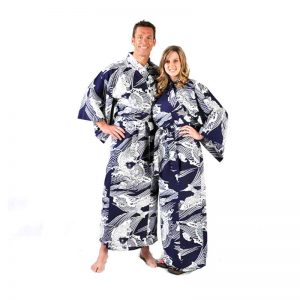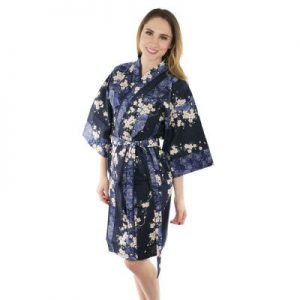Find Your Perfect Fit with Kimonos for Every Body Type
Striking the perfect balance between tradition and contemporary fashion, kimonos offer an unmatched blend of style, comfort, and versatility. Whether you’re lounging at home or looking to make a unique fashion statement, there’s a kimono for every occasion – and every body type. From small through XL, plus-size, big and tall, to tall and short-length robes, today’s kimonos are designed to fit and flatter everyone. Let’s explore their cultural significance, the appeal of modern designs, and how to find the perfect kimono for your body type.
The Timeless Elegance of Kimonos
Originating in Japan, kimonos have deep roots in history and culture. For centuries, they symbolized social status, age, and marital status while also being an artistic expression through intricate designs and patterns. Traditionally made from silk, kimonos showcased craftsmanship that turned fabric into wearable art.
Over the years, kimonos have transcended their traditional framework. Today, they’re celebrated globally in a variety of styles, materials, and forms, blending cultural heritage with modern-day design. From vacation-worthy beach cover-ups to luxurious lounging robes and chic outerwear, there’s no shortage of ways to incorporate kimonos into your wardrobe.
Why Kimonos Are for Everyone
One of the main attractions of kimonos is their adaptability for every body type. With their loose, flowing structure and adjustable fits, kimonos accommodate movement and comfort while maintaining a flattering silhouette. They cater equally to men and women, offering inclusivity that many clothing items struggle to achieve.
Available Sizes
1. Standard Sizes (Small through XL)
For individuals who fall into standard sizing, kimonos provide a tailored yet relaxed look. Small to XL options are widely available, with precise cuts that keep you looking polished whether you’re at home or heading out.
2. Plus-Size Kimonos
Stay effortless and chic with plus-size kimonos designed to suit curves beautifully. Look for features like wide waist ties, slightly flared sleeves, and generous lengths to enhance comfort while still offering a stylish fit.
3. Big and Tall Options
Big and tall kimonos cater to those who require longer lengths and broader cuts. These designs ensure the right proportions without compromising on the flowing drape and elegance that kimonos are known for.
4. Short-Length Kimonos
Prefer something shorter? For those on the petite side or seeking casual, cropped styles, short-length kimonos are a perfect solution. These are ideal as breezy outerwear or loungewear for a light and easy look.
5. Tall-Length Kimonos
Tall-length robes offer extended hems for those with longer frames. Whether you’re lounging or accessorizing your outfit, these provide an elegant, elongating effect.
How to Choose the Right Kimono
While kimonos are effortlessly stylish, selecting the right fit and material can make all the difference. Here’s how to choose wisely for your needs:
1. Body Shape Consideration
- For Petite Frames: Opt for cropped or knee-length kimonos with softer fabrics to avoid overwhelming a smaller frame.
- For Taller Individuals: Long, floor-grazing styles accentuate height beautifully while maintaining that classic flow.
- For Curvier Shapes: Go for kimonos with structured belts or ties to define the waist and highlight curves.
2. Keep the Occasion in Mind
- Loungewear: Look for lighter fabrics like cotton or poplim for ultimate comfort.
- Outerwear: Silk or satin materials don’t just look luxe but also pair well with jeans, dresses, or slacks as part of a layered outfit.
- Formal Events: Choose hand-embroidered or printed kimonos for an elegant, eye-catching finish to your look.
3. Pay Attention to Colors and Patterns
- Light, neutral tones create a subtle, relaxed vibe.
- Bold patterns and brighter shades stand out if you’re going for a statement piece.
- For a nod to tradition, look for designs inspired by nature, like cherry blossoms, cranes, or waves.
4. Prioritize Comfort
Kimonos are known for their breathable and loose structure. Always choose materials that keep you comfortable, whether it’s soft cotton for warm weather or luxurious velvet for chilly evenings.
Styling Tips for Men and Women
- For Women: Pair your kimono with a simple top and leggings for casual outings or drape it over a dress for something more formal. Shorter kimonos double as chic cover-ups at the beach or pool.
- For Men: Layer your kimono robe over a basic T-shirt and jeans or lounge pants for a mix of contemporary and classic. Neutral colors like navy, black, or earth tones offer versatility, while brighter prints can be a bold addition to your wardrobe.
The Modern Appeal of Kimonos
Kimonos are no longer bound by geography or occasion. They’re a staple in global fashion that blends comfort with timeless appeal. With designs to fit every size and occasion, they’ve rightfully earned their place as a go-to garment in many wardrobes.
Their adaptability has made them a favorite for festivals, casual weekend looks, and even formal events. With options ranging from understated elegance to dazzling opulence, there’s truly a kimono for everyone.
Explore and Find Your Perfect Kimono
Whether you’re looking for a cozy loungewear option or a bold statement piece, a kimono is the perfect addition to your wardrobe. With styles and sizes to suit everyone, it’s never been easier to find one that matches your personality and body type.
Explore the endless options and discover how a kimono can bring an effortless yet refined touch to your style. Start your search today—and step into the world of comfort and elegance!








